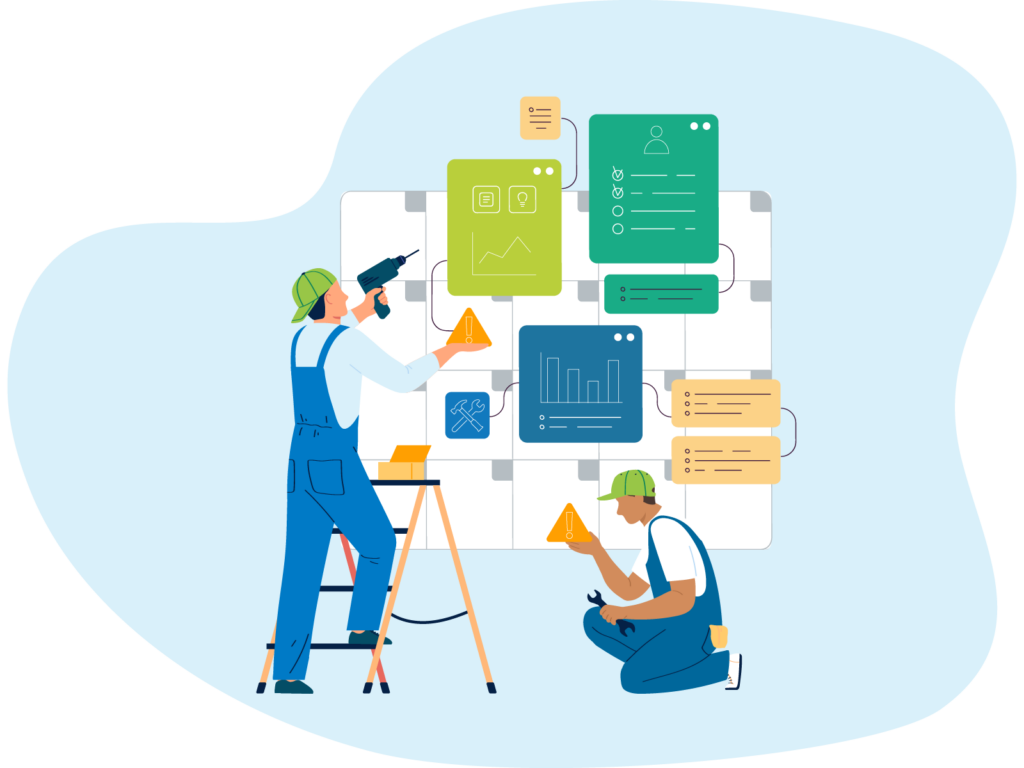Onboarding: The key ingredient for CAFM software success
Without a strong onboarding strategy, the potential of your CAFM solution can be hindered right from the outset. Find out why – and how to avoid this – here.
The evolution and diversification of CAFM software over the years has revolutionised the way that businesses function.
Facilities management teams that were once left overstretched and overburdened by manual processes and mile-long paper trails have been empowered to work more efficiently, cost-effectively and meaningfully through solutions such as MRI Evolution.
However, you may have identified the most sophisticated CAFM system that meets your requirements perfectly. It could have all the modules and components you could ever need. It could seamlessly integrate with your existing technologies. But this alone is not enough.
Fundamentally, the initial and ongoing success of a CAFM solution is largely influenced by how well it is onboarded. If the onboarding process doesn’t run smoothly, it can significantly hinder the adoption of your software, and consequently the return on investment it generates.
What is onboarding?
The onboarding stage covers the initial introduction and installation of your CAFM system into your organisation.
This stretches from the immediate discussions with your vendor on what you require from your solution, all the way through to setting up your accounts and training your team to use it well. It’s the span of time that lays the foundation for how your product is used and how effective it fulfils its intended purposes.
Onboarding is a multifaceted and potentially complex process. It demands regular consultations and communication between the customer and the vendor. Sophisticated data integration and software installation. Spotless organisation and diligent tracking of each milestone in the pipeline. Clear, digestible training sessions and resources.
It sounds complex, and it very easily can be. But, when determining the right software for your company, a big factor in your decision-making process is identifying the vendor that can make this process as seamless (and painless) as possible, while covering all bases to ensure your system is built-for-purpose and ready for action immediately.
Why is the onboarding stage so critical?
There are several reasons why getting the onboarding of any CAFM software spot on is so crucial, regardless of how powerful it is in theory:
Expanding users’ understanding of the system’s capabilities
A successful onboarding stage should leave everyone who will be using the CAFM software on a regular basis in no doubt on what it is capable of doing for them. These systems are both highly sophisticated and highly customisable – with MRI Evolution, no two systems are created in the same template.
By engaging in thorough discussions with your vendor about your expectations, and receiving in return regular feedback on how your system will function day-to-day, you are better placed to hit the ground running right away with this technology when the green light is given. Above all else, onboarding is critical in informing your team what they will get out of their new product.
Enabling team members to use the system as intended
As well as giving you a clear sense of what your CAFM software can do and how it will benefit your daily operations, onboarding should also demonstrate to users how they should use the system. This includes what devices they can use it from, how to navigate various dashboards and data, submit information and more.
Multiple people from across the length and breadth of your team will harness your CAFM solution for a variety of purposes (particularly if it is as all-encompassing as MRI Evolution is). Training them during onboarding ensures they can use these systems with confidence, and that the systems will subsequently generate returns on your investment.
Encouraging team members to buy-in to this new approach
People are typically creatures of habit, and can often be hesitant to the prospect of change. And, no matter how comprehensive your CAFM software is, if nobody is willing to use it, it will never return the investment that you’ve made into it.
By providing a full scope of how the system works, how users can engage with it and the information it provides, the onboarding process should act to replace the initial resistance some may have towards this change with reassurance on how this is going to improve their lives for the foreseeable future.
When users see and understand the difference, that switch becomes infinitely more straightforward to make – a good onboarding stage makes this possible.
Laying the foundations for a strong customer-vendor relationship
The continued success and optimisation of your CAFM software is heavily reliant on a sustained, supportive relationship between you, the customer, and your chosen vendor. If there is any break in this collaboration, it can limit the potential of your software to evolve to meet the ever-changing circumstances of your business.
This relationship begins in earnest during the onboarding process. A solid onboarding experience breeds trust and mutual respect between both sides, meaning that your team will be more welcoming and receptive to updates and ideas. Furthermore, your vendor will be motivated to continue to give their all to enhance your system, and not down tools after the immediate installation.
Maximising the potential of your CAFM software
At the centre of everything, onboarding is about setting up the customer with the system, guidance and support they need to make the most of their new product. Acquiring an effective, comprehensive CAFM software solution means making a substantial investment – and you’ll want to start seeing the benefits it offers your business soon.
Ensuring that every user is familiarised and trained with the new system, and it contains all of the features and functions you require in your organisation, is vital in generating that ROI. That is the difference a great onboarding experience gives over a substandard one.
13 elements to a successful onboarding process
Now it’s been clearly established why onboarding is so important and the value a successful example of this delivers, what actually makes an ideal onboarding experience?
From our decades of experience onboarding, installing and integrating CAFM software for customers worldwide, we have constructed a list of 13 essentials that your vendor should fulfil as part of your onboarding process. Keep these in mind as they should play an important role in deciding which system vendor you proceed with.
1. Software installation & configuration
Your vendor’s software engineers should be well-trained and demonstrate a clear, complete understanding of your system’s unique capabilities. From the outset your installation team should be in regular communication with you about the features of your software and if this needs to be revised over the course of installing and configuring this.
2. Database setup & configuration
One of the biggest benefits CAFM software offers to FM teams is the condensing of information into one, manageable space. To reap the most from this advantage, during onboarding your database needs to be set up appropriately to contain the specific data you need it to contain.
3. Data cleansing, manipulation & import
Today’s businesses are driven by data, so it needs to be accurate and reliable. The cleansing and manipulating of your existing data into the system therefore must be done with great care and attention, with consistent discussion between you and your vendor. By the end of the onboarding process, all relevant data should be imported in a comprehensible way.
4. Front-end system configuration
To ensure your users become accustomed to utilising your CAFM system on a frequent basis, it needs to offer a strong user experience. This is determined by how well the front-end of your software is configured, so this is another aspect you must verify that your vendor is capable of delivering.
5. Clear design specification
Your vendor should be able to present and explain the design and specifications of your system at all times, and communicate if any alterations are made over time. This should always be made as digestible as possible, so you’re never left in any doubt over how your final product will operate.
6. Detailed project plans
Once the specifications for your product are set in stone, your vendor should propose a clear plan-of-action for how this project will progress, including key milestones relating to time and budget, and who will be accountable for ensuring that all deadlines are met.
7. Structured workflow processes
Alongside overall project plans, there should be workflows assigned to the relevant engineers and people within your team, and what they need to achieve in order to meet the targets set for the onboarding process.
8. System automation design & creation
A big reason why so many have made the transition to CAFM software is that it eliminates the time-consuming manual burdens of traditional FM approaches. For that to be successful, the process of confirming the system is automated needs to be done competently.
9. 3rd-party integration approach
Your CAFM software should seamlessly settle into the existing software you have in place in your business. Your vendor should go the extra mile to identify ways to integrate your longstanding technology with no complications – something that we pride ourselves in doing for customers employing our Concept Evolution platform.
10. Mobile solution implementation
The very best CAFM software available fits into today’s mobility-focused, app-driven landscape. If you want to unlock these benefits for your business, your onboarding process should demonstrate the connections between your central, cloud-based CAFM solution and your users’ mobile devices.
11. Consultation on best practices
Throughout the onboarding process, but particularly towards the conclusion, conversations and training should take place between the software developers and your team to get a firm grasp on how the platform should be used. Without this direct consultation, you may struggle to hit the ground running with your solution.
12. Operational testing
Testing of your CAFM software before it is put live should be thorough and organised, ensuring that any issues are identified, highlighted and resolved to minimise any issues hindering your system from the outset.
13. Ongoing support network
Finally, to keep your system working at the optimal level, the onboarding experience should clarify how you can reach out to the vendor for continued support and training. Plus, it should outline any processes they have in place to revisit software at regular intervals to discuss any problems and propose useful updates.
How FSI guarantees flawless implementation and delivery
It cannot be overstated how important onboarding is to unlocking the full potential of your CAFM software. When installed correctly and placed in the hands of users that fully appreciate how their system will fit into their daily routines, systems such as MRI Evolution can completely transform the efficiency and productivity of your organisation for the better.
But, that transition to a better, brighter tomorrow for your FM teams is founded on a solid onboarding experience. As we’ve highlighted above, this confirms that your unique system fulfils the unique requirements of your organisation, and that everyone who needs to use it buys into it, so it can start to pay back the investment made into it.
That’s why at FSI, our consultancy services have been developed to detangle the complexities of CAFM software and deliver a complete, powerful product for our customers.
- Configuration without complication, no matter the sophistication or breadth of your requirements
- Digestible roadmaps for product implementation, identifying, documenting and more
- Meticulous monitoring by a dedicated Project Manager, committed to providing the best possible client experience
- Our complimentary, zero commitment System Healthcheck will always verify that you are getting the most from your system, with easy-to-digest reports identifying any proposals that could save you time and money
- Benefit from Admin-on-Demand, allowing work to be actioned at a time and duration to suit you – create new users, modify user permissions, update assets and PPMs, modify SLA structures and more with immediate assistance from our dedicated team
Contact us today to discuss our FM software solutions and how we can implement these into your existing operations.
Facilities Management software
Leading solutions for property occupiers, owners and service providers & contractors.
Get a demo
Discover the key trends and challenges impacting facility managers
From the adoption of new technologies to the need to adapt practices to suit today’s hybrid working requirements, Facility Managers are being asked to balance numerous responsibilities and priorities. Download our webinar that delves into the ever-ch…

